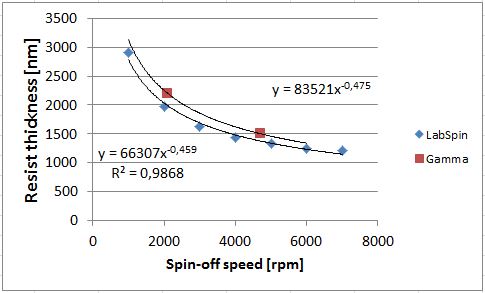Specific Process Knowledge/Lithography/5214E: Difference between revisions
No edit summary |
|||
| (14 intermediate revisions by 2 users not shown) | |||
| Line 1: | Line 1: | ||
{{:Specific Process Knowledge/Lithography/authors_generic}} | |||
'''Feedback to this page''': '''[mailto:labadviser@nanolab.dtu.dk?Subject=Feed%20back%20from%20page%20http://labadviser.nanolab.dtu.dk/index.php/Specific_Process_Knowledge/Lithography/5214E click here]''' | |||
[[Category: Lithography|Resist]] | |||
[[Category: Resist|AZ 5214E]] | |||
__TOC__ | |||
==Resist description== | |||
AZ 5214E is a positive UV photoresist with image reversal capability. It is considered to have good adhesion when wet etching. | |||
Spin | ==Spin coating== | ||
[[Image:5214Espincurves.JPG|500x500px|thumb|Spin curves for AZ 5214E (old German version) using a 30 s spin-off, and a 60s @ 90°C softbake]] | |||
Soft bake: | '''Typical spin parameters:''' | ||
*Spin off: 30-60 s | |||
*Soft bake: 60 s @ 90°C | |||
<br clear="all" /> | <br clear="all" /> | ||
==Image reversal== | ==Image reversal== | ||
'''Typical image reversal parameters:''' | |||
*Reversal bake temperature: 110°C | |||
*Reversal bake time: 60 s | |||
*Flood exposure: 500 mJ/cm<sup>2</sup> | |||
If the substrate is flood exposed after the reversal bake, the previously unexposed areas become soluble, and will be removed in the subsequent development. The reversal procedure effectively makes AZ 5214E a negative resist. | If 5214E is baked after exposure, the exposed resist will cross-link, making it insoluble in the developer. This is called the "Reversal bake". The reversal bake activates cross-linking of the exposed areas, which "reverses" the polarity of the design. When the substrate is flood-exposed after the reversal bake, the previously unexposed areas become soluble, and will be removed in the subsequent development. The image reversal procedure effectively makes AZ 5214E a negative resist. | ||
The image reversal process greatly increases the sensitivity of AZ 5214E, and the dose of the image exposure is a critical parameter, especially if negative angled resist sidewalls are desired.<br> | The image reversal process greatly increases the sensitivity of AZ 5214E, and the dose of the image exposure is a critical parameter, especially if negative angled resist sidewalls are desired. In coatings below 2 µm, it is difficult to achieve undercut.<br> | ||
Half dose of the normal, positive process is a good starting point for optimization. Similarly, the reversal bake is also a critical step, and must be tightly controlled in order to achieve consistent results. If negative sidewalls are desired, 60- | Half dose of the normal, positive process is a good starting point for optimization. Similarly, the reversal bake is also a critical step, and must be tightly controlled in order to achieve consistent results. If negative sidewalls are desired, 60 - 120 s at 110°C is recommended (as well as a resist thickness above 2 µm), but if straight sidewalls are desired, 60 - 120 s at 120°C can be used. | ||
The flood exposure, on the other hand, is uncritical, and | The flood exposure, on the other hand, is uncritical, and ~5 times the normal positive process dose is generally used. | ||
==Development== | ==Development== | ||
'''Development speed in 2.38% TMAH (AZ 726 MIF): | '''Development speed:''' | ||
*Puddle development in 2.38% TMAH (AZ 726 MIF): ~2 µm/min | |||
Latest revision as of 14:23, 25 August 2025
This section, including all images and pictures, is created by DTU Nanolab staff unless otherwise stated.
Feedback to this page: click here
Resist description
AZ 5214E is a positive UV photoresist with image reversal capability. It is considered to have good adhesion when wet etching.
Spin coating

Typical spin parameters:
- Spin off: 30-60 s
- Soft bake: 60 s @ 90°C
Image reversal
Typical image reversal parameters:
- Reversal bake temperature: 110°C
- Reversal bake time: 60 s
- Flood exposure: 500 mJ/cm2
If 5214E is baked after exposure, the exposed resist will cross-link, making it insoluble in the developer. This is called the "Reversal bake". The reversal bake activates cross-linking of the exposed areas, which "reverses" the polarity of the design. When the substrate is flood-exposed after the reversal bake, the previously unexposed areas become soluble, and will be removed in the subsequent development. The image reversal procedure effectively makes AZ 5214E a negative resist.
The image reversal process greatly increases the sensitivity of AZ 5214E, and the dose of the image exposure is a critical parameter, especially if negative angled resist sidewalls are desired. In coatings below 2 µm, it is difficult to achieve undercut.
Half dose of the normal, positive process is a good starting point for optimization. Similarly, the reversal bake is also a critical step, and must be tightly controlled in order to achieve consistent results. If negative sidewalls are desired, 60 - 120 s at 110°C is recommended (as well as a resist thickness above 2 µm), but if straight sidewalls are desired, 60 - 120 s at 120°C can be used.
The flood exposure, on the other hand, is uncritical, and ~5 times the normal positive process dose is generally used.
Development
Development speed:
- Puddle development in 2.38% TMAH (AZ 726 MIF): ~2 µm/min
